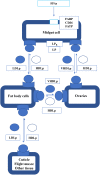The metabolism and role of free fatty acids in key physiological processes in insects of medical, veterinary and forensic importance
- PMID: 35036124
- PMCID: PMC8710053
- DOI: 10.7717/peerj.12563
The metabolism and role of free fatty acids in key physiological processes in insects of medical, veterinary and forensic importance
Abstract
Insects are the most widespread group of organisms and more than one million species have been described. These animals have significant ecological functions, for example they are pollinators of many types of plants. However, they also have direct influence on human life in different manners. They have high medical and veterinary significance, stemming from their role as vectors of disease and infection of wounds and necrotic tissue; they are also plant pests, parasitoids and predators whose activities can influence agriculture. In addition, their use in medical treatments, such as maggot therapy of gangrene and wounds, has grown considerably. They also have many uses in forensic science to determine the minimum post-mortem interval and provide valuable information about the movement of the body, cause of the death, drug use, or poisoning. It has also been proposed that they may be used as model organisms to replace mammal systems in research. The present review describes the role of free fatty acids (FFAs) in key physiological processes in insects. By focusing on insects of medical, veterinary significance, we have limited our description of the physiological processes to those most important from the point of view of insect control; the study examines their effects on insect reproduction and resistance to the adverse effects of abiotic (low temperature) and biotic (pathogens) factors.
Keywords: Adaptation to cold; Fatty acid transport protein; Free fatty acid; Insect physiology; Lipophorin; Polyunsaturated fatty acid.
©2021 Kaczmarek and Boguś.
Conflict of interest statement
The authors declare there are no competing interests.
Figures


Similar articles
-
Insect pathogens as biological control agents: Back to the future.J Invertebr Pathol. 2015 Nov;132:1-41. doi: 10.1016/j.jip.2015.07.009. Epub 2015 Jul 27. J Invertebr Pathol. 2015. PMID: 26225455 Review.
-
[Forensic entomology and globalisation].Parassitologia. 2004 Jun;46(1-2):187-90. Parassitologia. 2004. PMID: 15305714 Review. Italian.
-
Planning Implications Related to Sterilization-Sensitive Science Investigations Associated with Mars Sample Return (MSR).Astrobiology. 2022 Jun;22(S1):S112-S164. doi: 10.1089/AST.2021.0113. Epub 2022 May 19. Astrobiology. 2022. PMID: 34904892
-
Induced resistance in rice against insects.Bull Entomol Res. 2007 Aug;97(4):327-35. doi: 10.1017/S0007485307005056. Bull Entomol Res. 2007. PMID: 17645814 Review.
-
Side-effects of pesticides on non-target insects in agriculture: a mini-review.Naturwissenschaften. 2022 Feb 9;109(2):17. doi: 10.1007/s00114-022-01788-8. Naturwissenschaften. 2022. PMID: 35138481 Review.
Cited by
-
Repurposing Insecticides for Mosquito Control: Evaluating Spiromesifen, a Lipid Synthesis Inhibitor against Aedes aegypti (L.).Trop Med Infect Dis. 2024 Aug 18;9(8):184. doi: 10.3390/tropicalmed9080184. Trop Med Infect Dis. 2024. PMID: 39195622 Free PMC article.
-
Innovative Applications of Tenebrio molitor Larvae in the Production of Sustainable Meat Sausages: Quality and Safety Aspects.Foods. 2024 May 8;13(10):1451. doi: 10.3390/foods13101451. Foods. 2024. PMID: 38790751 Free PMC article.
-
Comparison of Growth and Composition of Black Soldier Fly (Hermetia illucens L.) Larvae Reared on Sugarcane By-Products and Other Substrates.Insects. 2024 Oct 6;15(10):771. doi: 10.3390/insects15100771. Insects. 2024. PMID: 39452347 Free PMC article.
-
Many parasitoids lack adult fat accumulation, despite fatty acid synthesis: A discussion of concepts and considerations for future research.Curr Res Insect Sci. 2023 Mar 30;3:100055. doi: 10.1016/j.cris.2023.100055. eCollection 2023. Curr Res Insect Sci. 2023. PMID: 37124650 Free PMC article. Review.
-
Microorganism Contribution to Mass-Reared Edible Insects: Opportunities and Challenges.Insects. 2024 Aug 13;15(8):611. doi: 10.3390/insects15080611. Insects. 2024. PMID: 39194816 Free PMC article. Review.
References
-
- Adedokun TA, Denlinger DL. Metabolic reserves associated with pupal diapause in the flesh fly, Sarcophaga crassipalpis. Journal of Insect Physiology. 1985;31:229–233. doi: 10.1016/0022-1910(85)90124-6. - DOI
-
- Alabaster A, Isoe J, Zhou G, Lee A, Murphy A, Day WA, Miesfeld RL. Deficiencies in acetyl-CoA carboxylase and fatty acid synthase 1 differentially affect eggshell formation and blood meal digestion in Aedes aegypti. Insect Biochemistry and Molecular Biology. 2011;41:946–955. doi: 10.1016/j.ibmb.2011.09.004. - DOI - PMC - PubMed
-
- Alves-Bezerra M, Klett EL, De Paula IF, Ramos IB, Coleman RA, Gondim KC. Long-chain acyl-CoA synthetase 2 knockdown leads to decreased fatty acid oxidation in fat body and reduced reproductive capacity in the insect Rhodnius prolixus. Biochimica Et Biophysica Acta - Molecular and Cell Biology of Lipids. 2016;1861:650–662. doi: 10.1016/j.bbalip.2016.04.007. - DOI - PMC - PubMed
LinkOut - more resources
Full Text Sources

